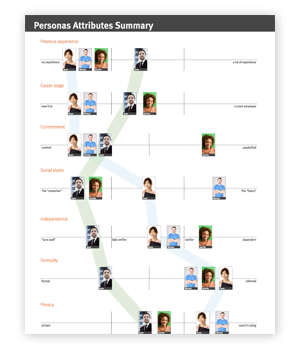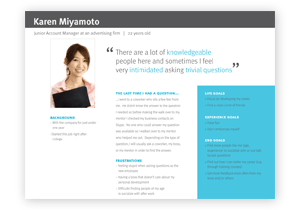User Research
Personas
Although we identified user needs in order to ensure that our solution would address the problems faced by millennial workers, we would need to address these needs in context. Thus, we generated personas that represented the usage and behavior patterns we observed in our research. The personas were primarily created as a design tool for the team so that we could condense our user data in a more digestible form. Later in the semester, we used these personas to validate whether our solution was properly addressing user needs.
We mapped our interview subjects onto a set of behavioral variables that would affect their use of a knowledge sharing solution (see Figure 1). For example, millennials would use our system differently depending on their length of time in the company, or their preference for seeking help from team members. We did this for our manager personas as well, but not for our HR persona as we did not observe a diversity in how they might use our system.
Although not specified in our personas, we also knew that our target millennial workers would be working in companies that are at least 2,500 employees, and that their most likely to be in either 1) Information Technology, 2) Professional, Scientific, and Technical Services, 3) Finance and Insurance, and 4) Educational Services, as reflected in our survey results. We also identified the following corporate goals that would not necessarily influence our personas’ usage patterns but rather influence the overall utility of our solution with respect to the corporation:
- Make money
- Retain and attract talent
- Develop talent
- Retain corporate knowledge
- Understand workforce’s knowledge
The breakdown of our eight personas is as follows: four millennials, two managers, one trusted non-millennial employee, and one human resources personnel. These represented the gamut of users that would potentially use our system. Initially, we wanted to pick all four millennials as our primary personas, our managers and trusted employee as secondary personas, and our HR personnel as a supplementary persona. However, after consulting with our client and our peers, we decided to narrow our primary personas down even further, otherwise, we would be attempting to design for too many divergent interests.
The two primary personas we settled on were Jason and Karen (see figures 2 and 3). We chose them because their attributes as mapped onto the axes (Figure 1) were quite distinct and cover a wide range of attributes: experienced employee vs. new college grad, formal vs. informal interactions with coworkers, outgoing vs. timid, etc. They would gain the most benefit from our system, particularly Karen, as she is very dependent on others in doing her work.





